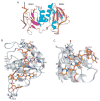Neuronal regulation of pre-mRNA splicing by polypyrimidine tract binding proteins, PTBP1 and PTBP2
- PMID: 22655688
- PMCID: PMC3422667
- DOI: 10.3109/10409238.2012.691456
Neuronal regulation of pre-mRNA splicing by polypyrimidine tract binding proteins, PTBP1 and PTBP2
Abstract
Alternative splicing patterns are regulated by RNA binding proteins that assemble onto each pre-mRNA to form a complex RNP structure. The polypyrimidine tract binding protein, PTB, has served as an informative model for understanding how RNA binding proteins affect spliceosome assembly and how changes in the expression of these proteins can control complex programs of splicing in tissues. In this review, we describe the mechanisms of splicing regulation by PTB and its function, along with its paralog PTBP2, in neuronal development.
Figures






References
-
- Auweter SD, Oberstrass FC, Allain FH. Solving the structure of PTB in complex with pyrimidine tracts: an NMR study of protein-RNA complexes of weak affinities. J Mol Biol. 2007;367:174–186. - PubMed
Publication types
MeSH terms
Substances
Grants and funding
LinkOut - more resources
Full Text Sources
Other Literature Sources
